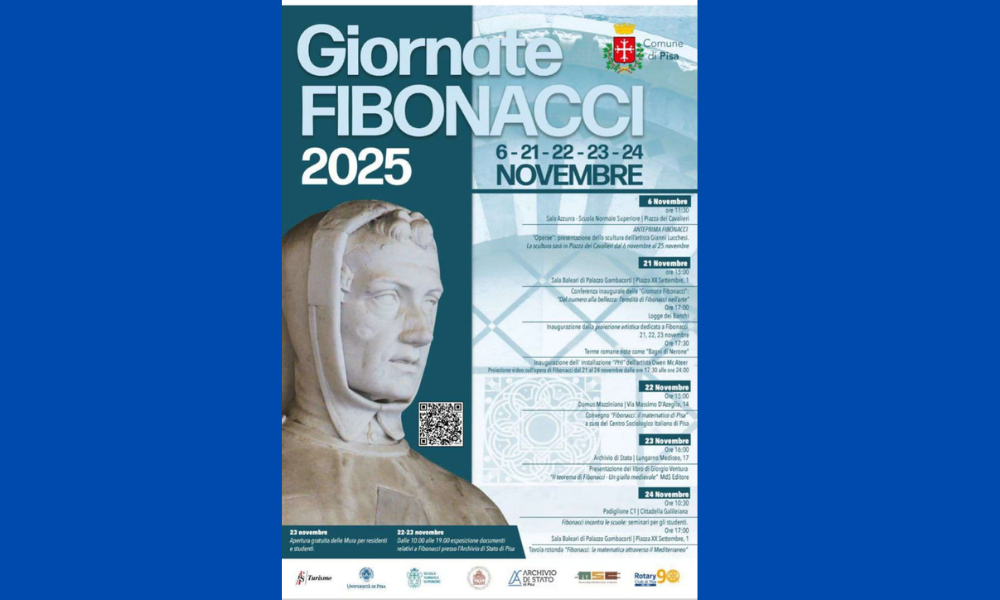Attualità
Fibonacci: dall’intreccio quantistico al rapporto aureo-Fibonacci: from quantum entanglement to the golden ratio

Fibonacci: dall’intreccio quantistico al rapporto aureo
di Marco Andreozzi
Dal 21 novembre Pisa ha ospitato il fine settimana lungo dedicato a Leonardo Fibonacci, la manifestazione istituita nel 2019 dal Comune insieme alle realtà accademiche e culturali della città-campus medievale per ricordare il grande matematico pisano vissuto tra XII e XIII secolo. A lui si deve l’introduzione in Italia e in Europa della scienza dei numeri indo-persiani appresa nel mondo arabo, fondamentale per lo sviluppo della matematica moderna (e senza ‘Analisi I’ può mai esserci un corso di ingegneria?). Fibonacci è noto soprattutto per la sequenza numerica che porta il suo nome: una progressione che parte da 0 e 1 e prosegue sommando ogni volta i due numeri precedenti (0, 1, 1, 2, 3, 5, 8, …). Il rapporto tra numeri consecutivi tende sempre più verso un valore costante, φ (phi), circa 1,618: il celebre rapporto aureo, affascinante fin dai tempi di Babilonia e delle piramidi egizie, mentre nell’antica Grecia, i pitagorici lo associarono a un simbolismo armonico legato al pentagono regolare, scorgendone l’unione del maschio e della femminile rispettivamente nella somma del 2 col 3: il numero dell’amore.

Il numero è detto aureo perché compare in molte strutture naturali: dalle spirali delle conchiglie alla disposizione delle foglie sulle piante, fino a molte composizioni artistiche rinascimentali. Negli ultimi anni, però, φ è riemerso in un ambito del tutto inatteso: la fisica quantistica, in particolare nello studio dell’intreccio, il fenomeno per cui due particelle possono diventare così correlate da condividere istantaneamente lo stato, anche se separate da grandi distanze. In alcuni modelli fisici e matematici basati su strutture ricorsive detti appunto sistemi Fibonacci – di cui un esempio semplice è la tecnica di risoluzione di problemi complessi attraverso la scomposizione in sottoproblemi più semplici – la distribuzione dell’intreccio quantistico segue proporzioni che ricordano il rapporto aureo. Accade soprattutto quando questi sistemi vengono portati a basse temperature, condizione in cui gli effetti quantistici prevalgono e il comportamento del materiale è dominato dallo stato fondamentale per cui la forza dell’intreccio porta ad un rapporto aureo.

Un altro esempio arriva dal campo emergente dei computer quantistici topologici. Alcune particelle teoriche, gli anioni di tipo Fibonacci, obbediscono a regole matematiche per cui la quantità di informazione quantistica che possono immagazzinare cresce secondo rapporti vicini alla spirale aurea. Allo stesso modo, in alcune strutture quasi-cristalline, il modo in cui gli elettroni si organizzano e si intrecciano può seguire scale geometriche che richiamano φ. È importante precisare: il rapporto aureo non è, almeno per ora, una costante fondamentale della meccanica quantistica. Ma il fatto che emerga in sistemi così diversi fra loro suggerisce qualcosa di più profondo: l’idea che alcune forme di complessità, ordine e armonia trovino una stessa espressione matematica tanto nella natura visibile quanto nel mondo subatomico. Una prospettiva che fa intravedere un universo sorprendentemente coerente, dove la matematica non è soltanto un linguaggio inventato dall’umanità, ma un’impronta ricorrente della realtà, riconoscibile dalla biologia fino ai buchi neri. Un universo in cui bellezza e complessità appartengono non solo alla natura visibile, ma anche al regno più profondo e inaccessibile della realtà, in tal modo lasciando forse spazio a quella libertà di cui gode la res cogitans (la sostanza del pensiero).
Fibonacci: from quantum entanglement to the golden ratio
by Marco Andreozzi
Since November 21, Pisa (in Tuscany) has hosted the long weekend dedicated to Leonardo Fibonacci, the event established in 2019 by the Municipality together with the medieval campus-town’s academic and cultural institutions to commemorate the great Pisan mathematician who lived between the 12th and 13th centuries. He is credited with introducing the science of Indo-Persian numbers, learned in the Arab world, to Italy and Europe, a fundamental step in the development of modern mathematics (And without ‘Math Analysis I’, can there ever be an engineering programme?). Fibonacci is best known for the numerical sequence that bears his name: a progression that starts from 0 and 1 and continues by adding the two preceding numbers (0, 1, 1, 2, 3, 5, 8, etc.). The ratio between consecutive numbers tends increasingly toward a constant value, φ (phi), approximately 1.618: the celebre golden ratio, fascinating since the time of Babylon and the Egyptian pyramids, while in ancient Greece, the Pythagorean associated it with a harmonic symbolism linked to the regular pentagon, seeing the union of the male and the female respectively in the sum of 2 and 3: the number of love.

The number is called golden because it appears in many natural structures: from the spirals of shells to the arrangement of leaves on plants, up to many Renaissance artistic compositions. In recent years, however, φ has re-emerged in a completely unexpected field: quantum physics, in particular in the study of entanglement, the phenomenon by which two particles can become so correlated that they instantly share a state, even when separated by great distances. In some physical and mathematical models based on recursive structures called Fibonacci systems – a simple example of which is the technique of solving complex problems by breaking them down into simpler subproblems – the distribution of quantum entanglement follows proportions reminiscent of the golden ratio. This occurs especially when these systems are brought to low temperatures, a condition in which quantum effects prevail and the material’s behavior is dominated by the fundamental state, so the strength of the entanglement leads to a golden ratio.

Another example comes from the emerging field of topological quantum computers. Some theoretical particles, Fibonacci-type anyons, obey mathematical rules whereby the amount of quantum information they can store grows according to ratios close to the golden spiral. Similarly, in some quasi-crystalline structures, the way electrons organize and entangle can follow geometric scales reminiscent of φ. It’s important to clarify: the golden ratio is not, at least for now, a fundamental constant of quantum mechanics. But the fact that it emerges in such diverse systems suggests something more profound: the idea that some forms of complexity, order, and harmony find the same mathematical expression both in visible nature and in the subatomic world. This perspective offers a glimpse of a surprisingly coherent universe, where mathematics is not just a human-invented language, but a recurring imprint of reality, recognizable from biology to black holes. A universe in which beauty and complexity belong not only in visible nature, but also to the deepest and most inaccessible realm of reality, thus perhaps leaving room for the freedom enjoyed by the res cogitans (the substance of thought).

Marco Andreozzi, è Dottore in Ingegneria Meccanica, Economia/Amministrazione (Politecnico di Torino). Tecnologo industriale e specialista del settore energetico, proviene da esperienze professionali in cinque multinazionali in Italia e paesi extra-europei, e come direttore generale da un quarto di secolo; nomade digitale dal 2004 al 2019, e’ sinologo, parla correntemente il mandarino e in Cina e’ stato docente a contratto.
Marco Andreozzi, is a Doctor in Mechanical Engineering, Economics/Administration (Polytechnic of Turin). Industrial technologist and specialist in the energy sector, he comes from professional practices in five corporates in Italy and non-European countries, and as managing director for a quarter of a century; digital nomad from 2004 to 2019, he is a sinologist, speaks fluent Mandarin and was a visiting professor in China.















